Summary:
“The Lamb” is a lyrical poem by William Blake, published in 1789 as part of his collection Songs of Innocence. The poem is written in a simple, childlike tone and explores themes of innocence, creation, and divinity. The poem takes the form of a question-and-answer structure, where the speaker—possibly a child—asks a lamb if it knows who created it. The second stanza answers the question, revealing that the Lamb was created by God, who is also called “The Lamb” (Jesus Christ). Blake uses the lamb as a symbol of innocence, purity, and the gentleness of God. The poem contrasts with The Tyger from Songs of Experience, which represents strength, power, and the darker aspects of creation. The poem emphasizes God’s kindness and the peaceful nature of creation. The poem’s famous opening lines are: “Little Lamb who made thee? Dost thou know who made thee?” The rhyming couplets, soft imagery, and repetitive structure make the poem sound like a nursery rhyme, reinforcing its theme of childlike innocence and faith.
10
Score: 0
Attempted: 0/10
Subscribe
| Question | Answer |
| Poem Name | The Lamb |
| Poet | William Blake |
| Year Published | 1789 |
| Poetry Collection | Songs of Innocence |
| Main Themes | Innocence, Creation, Divine Goodness |
| Contrasting Poem | The Tyger (from Songs of Experience) |
| Famous Line | “Little Lamb who made thee?” |
| Literary Devices | Personification, Symbolism, Rhetorical Questions |